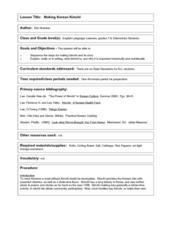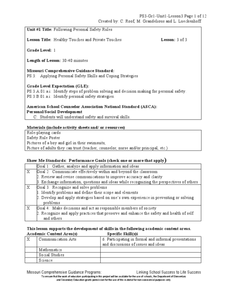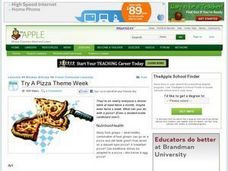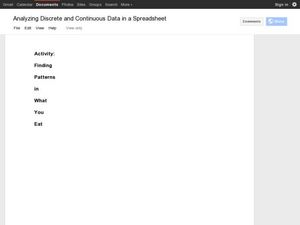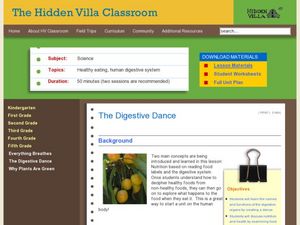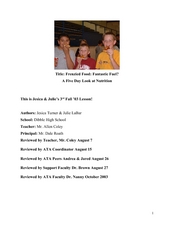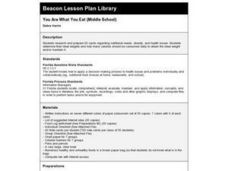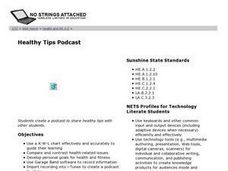Curated OER
Foods for Better Health
Students define biotechnology and discuss the economic impact of biotechnology. They also describe what a 1015 onion and a slow-softening tomato are and how they are produced. They examine the safety of genetically-engineered or altered...
Curated OER
Dietary Fiber
Students examine the different types of fiber and their benefits. In this investigative lesson plan students find good sources of fiber in different foods.
Curated OER
They Don't Just Eat Grass
Middle schoolers consider the USDA daily recommendations to create a "feed" product for middle schoolers. For this Health lesson, students learn about the ingredients in feed that is fed to livestock and apply the method to creating feed...
Curated OER
Making Korean Kimchi
Students make Korean Kimchi. In this Korean culture lesson, students follow the steps for making kimchi and learn about its background.
Purdue University
Healthy Body Image: Healthy Exercises for Every Body
From three-way neck rolls to a figure-5 hurdler's stretch, this is an ultimate guide to healthy exercises. It begins with a bulleted list of general guidelines on cardiorespiratory exercise, flexibility, resistance exercises, and range...
Curated OER
Home Living / Daily Living: Labels on Food Products
Everybody needs to know how to make healthy choices when it comes to food. Understanding food labels is the first step. Using empty food packaging, you'll discuss what food labels are, what information can be found on them, and how to...
Curated OER
Identify Healthy Food and Lifestyle Choices
Poll your scholars about their choices on food they eat, or don't eat, and on maintaining a healthy lifestyle. Topic statements such as "I ate breakfast this morning" start a discussion on what are healthy choices and what are unhealthy...
Curated OER
The ABC's of Breakfast
Students identify the food group of various culturally diverse breakfast foods and discuss the importance of eating a healthy, well-balanced breakfast every morning. They then try different foods that begin with the letter A, B and C and...
Curated OER
Healthy Touches and Private Touches
First graders listen and share ideas. They role play situations where they would use the safety rules and share different kinds of touches that make them feel comfortable, uncomfortable or confused. They discuss what a person can do when...
Curated OER
Try A Pizza Theme Week
Students explore all the things they could do with a pizza. They become aware of food groups and nutritional needs, make decorated cardboard pizzas, interact with pizza slices and fractions, create stories to go along with their...
Curated OER
Where's the Beef - Beef Facts or Hype, Is it Bad for You?
Analyze a Happy Meal™ for nutrient content and calories. Blend the contents into "McMush" and use Biuret's solution to test for protein content. There are a few problems with the lesson plan: the resource links are no longer valid, the...
Curated OER
Analyzing Discrete and Continuous Data in a Spreadsheet
You are what you eat! Your statisticians keep a log of what they eat from anywhere between a day to more than a week, keeping track of a variety of nutritional information using a spreadsheet. After analyzing their own data, individuals...
Curated OER
The Digestive Dance
Students read food labels to compare healthy verses non healthy food and then use diagrams to create a poster of the digestive system. In this food lesson plan, students move the food down the digestive track along the digestive system.
Curated OER
Benefits of Nutrients
Explore the nutrients a body needs using this resource. Learners discuss the importance of the relationships between proteins, fats, carbohydrates, vitamins, minerals, and water. It's a great way to have your class talk about the healthy...
Curated OER
Home Living / Daily Living : Foods with Vitamins and Minerals
Bridge the gap between health and food for your special needs class. Through discussion and handouts, they will be introduced to the basics regarding the vitamins and minerals we get from eating healthy foods. They work to identify...
Baylor College
Digestion
Digestion is an amazing and complicated process that provides humans with the energy they need to survive. Lesson six in this series on the science of food uses sliced turkey and a meat tenderizer to demonstrate how enzymes help break...
Education Outside
Grains and Food
Gather up a variety of foods made from grains. Cereal, oats, pasta, rice, breads, cookies, crackers, to name a few. Put them in plastic containers or plastic bags. Then do a show-and-tell type demonstration and present all the types of...
Curated OER
Fast Food Junkie
Fourth graders study their favorite fast food meal and analyze their nutritional value.
Curated OER
Frenzied Food: Fantastic Fuel?
Students infer the causes of obesity. In this health science lesson, students brainstorm ways improve to their diet. They write personalized journals with goals on how to live a healthy lifestyle.
Curated OER
You Are What You Eat (Middle School)
Third graders determine what their ideal weights should be and how many calories should be consumed daily to obtain the ideal weight and/or maintain it. They research and prepare 20 cards regarding nutritional needs, obesity, and health...
Curated OER
Changing unhealthy eating habits
Learners identify the elements of a balanced diet, then compile a daily diet and exercise log to assess their lifestyles and improve them if applicable. They recognize and explain the importance of proper nutrition practices.
Curated OER
Food Pyramid
First graders examine the different levels of the food pyramid and plan a healthy meal. They discuss the food pyramid and read about nutrition using a variety of resources. Using Kidspiration computer software, they plan a...
Curated OER
Build a Burger
Pupils read about hamburgers and analyze a healthy diet as well as the importance of nutrition. In this nutrition education activity, students read the background information about hamburgers and their nutrition facts. Pupils complete...
Curated OER
Healthy Tips Podcast
Students create a health-based podcast for peers using prior knowledge, internet research, and KWL charts. This lesson is adaptable for different health topics and age levels.





